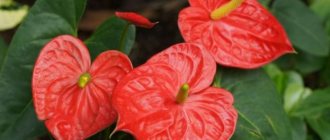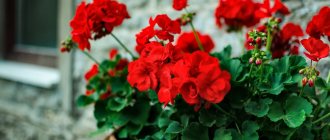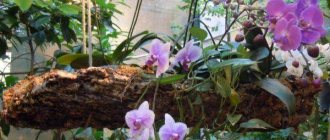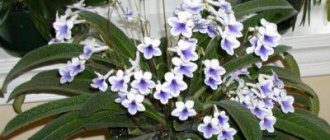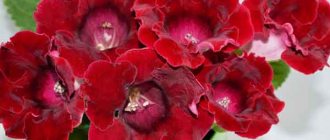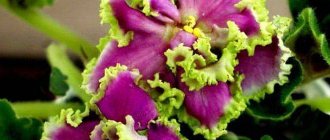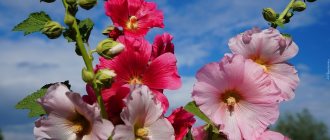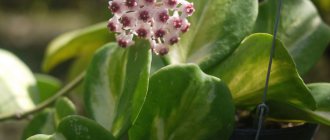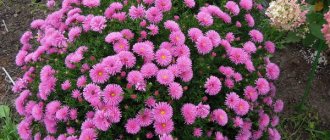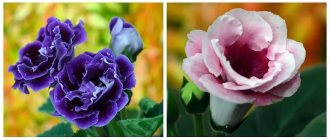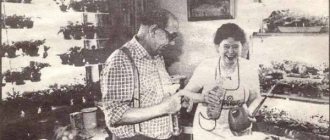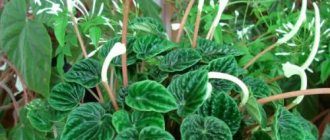Anthurium - features and description of a garden flower
This crop, also called “Flamingo flower,” is one of the most popular species of the Araceae family. The variety of forms allows you to grow it as a houseplant or garden plant. There are also some varieties, the description of which suggests breeding specifically for cutting, for sale in bouquets and bright compositions.
Anthurium leaves are leathery, massive, can be solid or dissected, most often dark green, with a monochromatic or multifaceted pattern on the surface, it depends on the shape and the specific variety. The flowers are beautiful, they come in blue, white, red, orange, and take on almost all variegated shades - lilac, violet, purple. Regardless of the type, they have a pronounced and pleasant aroma.
The flower is considered relatively unpretentious, unlike many other tropical forms. The main thing is to follow the basic rules of care, water, feed and monitor the condition of the plant on time. It is often used in greenhouses and as an original part of bright landscape design. Only from a few different varieties can you create a unique and beautiful composition in the garden or indoors.
Indoor anthurium is considered a masculine flower; it is not without reason that people call it nothing more than “Men’s Happiness.” There is a belief that a bright flower given to the stronger sex brings its owner a positive surge of emotions and strength, and brings a lot of passion and love to the lovers’ home.
Description of the Anthurium plant
Anthurium is a large genus of evergreen, herbaceous plants from the Araceae family. The Latin name "Anthurium" has Greek roots and in the language of the ancient Greeks means "flower and tail."
More than 900 species of anthuriums have been found in nature, which are represented by epiphytes, semi-epiphytes, lithophytes, creeping, climbing and creeping specimens.
The external features of the plant vary depending on the species. Leaf plates can be of various sizes, shapes, textures and colors. The foliage can be collected in rosettes, or it can grow singly on petioles. The leaves have the ability to turn after the sun.
However, the main value of Anthuriums is flowers. It is thanks to them that the plant was able to survive for thousands of years. The appearance of flowers attracts not only humans, but also many insects and birds, which contributes to the preservation and spread of the plant.
Anthurium blooms all year round. Its flowers are presented in a wide range of colors, have dense glossy petals in the form of a continuous blanket with an inflorescence in the form of a cob. In this case, the cob can take different shapes - be straight, twist in a spiral.
Anthurium flowers have a pronounced aroma, but not all the smells of this plant are pleasant. Some species emit foul odors to attract insects.
Cut flowers can live in water for up to a month, so they are often used by florists to decorate flower arrangements. For their minimalist and sophisticated flower and foliage forms, anthuriums are a favorite among interior designers.
The flowering of Anthurium ends with the ripening of fleshy fruits, which contain two seeds. But fruit set is only possible if the flowers have been pollinated.
The juice of Anthurium stems and leaves contains toxins, so it can cause allergic reactions on the skin and poisoning if it comes into contact with mucous membranes.
Review of popular plant varieties
Anthurium Andre. One of the most popular species with many hybrid forms, which is represented in nature by an epiphytic flower from the mountain forests of Colombia and Ecuador with short stems and aerial roots. The leaves are bright green, quite large in size, in the shape of a glossy heart, reaching up to 20 centimeters in width and up to 50 in length.
The flower is represented by a large “cob” of bright yellow or cream color with a leaf-spread of a variety of colors, from white-pink to burgundy-red, depending on the specific hybrid. The flowering period is about 1.5 months; at the end, the massive part of the inflorescence takes on a light green color. The most popular subspecies are: Arizona, Polaris, Pink Champion, Marasol, Cuba.
Baker's Anthurium. Another well-known variety with a short stem (up to 0.5 meters) and long, narrow leaves that take on a “belt-like” shape. The inflorescence is massive, on it grows a spadix of a cream or bright yellow color with a bright green spathe with purple edges. Very picky about care. In order for it to grow properly and delight the owner with its wonderful aroma, it is worth providing conditions as close to tropical as possible, strictly observing the temperature and quality of watering.
Crystal (majestic). Perhaps the most beautiful and spectacular of all types of anthurium that can be grown at home. The plant is characterized by a short, underground stem and velvety, green leaves with silvery veins on the outside that have a bright, crystal luster. Bracts are very sensitive to temperature changes and especially to low temperatures; for normal cultivation it is necessary that the room always be at least 17-18 degrees.
Anthurium Scherzer. Epiphytic plant with non-shiny, leathery dark green leaves. They have several variants of shapes and are dotted with dots of black or other shades on both sides of the leaf plate. The cob is twisted in a spiral, red, yellow or bright orange; the spathe is dense, bright, and most often takes on an elliptical shape. Among the most common indoor types are:
- Arinos, Smaragd, Unica with a green flower cover;
- red Artus, Rustica or Hannah;
- Lacetti with a bright pink flower and an orange spiral in the center.
In addition to the species presented, varieties and varieties of anthurium such as Climbing, Hooker Flower, Violet, and Dissected are also popular for growing in gardens or greenhouses.
Anthurium varieties Andre and Scherzer by color
There are a huge number of hybrid forms of “male happiness” and there are more and more of them every day. We present the most popular and affordable Andre and Scherzer anthurium varieties with names and photos, and also indicate less common forms.
White
The most popular white varieties: “Champion White” (White champion, white champion), “Sumi” (Sumi). White and pink: “Princess Amalia Elegance” (Princess Amalia Elegance).
"Champion White" (White champion, white champion), "Sumi" (Sumi) and "Princess Amalia Elegance" (Princess Amalia Elegance).
Red
The most famous red varieties: “Dakota” (Dakota), “Sierra Magic” (Sierra Magic), “Turenza (Perfectred)” (Turenza).
Red-green: Anthurium adrianum 'Baby Boom'.
Others: Almera, Bugatti Veyron, Champion Red, Dynamite Red, Red King, Royal Champion" (Royal champion), "Success Red" (Success ed).
"Dakota" (Dakota), "Sierra Magic" (Sierra Magic), "Turenza (Perfect red)" (Turenza) and "Baby Boom" (Baby Boomer).
Orange
Orange variety: "Picasso Orange" (Picasso orange).
Orange-red forms: "Baby Orange", "Madural Orange", and also "Princess Orange".
"Picasso Orange", "Baby Orange" and "Madural Orange"
Pink
Pink varieties: “Joli” (Jolie), “Lady Love” (Lady Love), “Pink Alabama” (Pink Alabama) and “Pink Champion” (Pink Champion, pink).
Other forms: “Picasso Pink” (Picasso pink, pink), “Pink King” (Pink King), “Pink Queen”.
"Joli" (Jolie), "Pink Alabama" (Pink Alabama) and "Pink Champion" (Pink Champion, pink).
Pink-green: “Fantasy Love” (Fantasy Love), “Leganza” (Leganza), “Pandola” (Pandola).
“Fantasy Love” (Fantasy Love), “Leganza” (Leganza) and “Pandola” (Pandola).
Violet (lilac or lilac)
Purple varieties: Cavalli Purple, Fiorino and Utah. Also an interesting option: “Picasso Purple” (Picasso purple).
"Cavalli Purple" (Cavalli Purple), "Fiorino" (Fiorino) and "Utah" (Utah).
Blue and blue anthurium: painted or not?
“Male happiness” does not have a gene for blue or blue color (pigment), therefore, it is impossible to breed a variety with a similar color of the bedspread. According to specialists from the Faculty of Biology of Moscow State University, the samples presented today are flowers painted using special ink injections into the peduncle.
For example, the Dutch company offers the blue anthurium variety “Princess Alexia Blue” and the bright yellow flower “Princess Alexia Yellow” using this technology. Famous blue variety: "Picasso Blue" (Picasso blue (blue)).
"Picasso Blue" (Picasso blue (blue)) and "Princess Alexia Blue" (Princess Alexia blue).
Yellow
“Picasso Yellow” (Picasso yellow), “Princess Alexia Yellow” (Princess Alexia yellow), “Vanilla” (Vanilla, vanilla).
“Picasso Yellow” (Picasso yellow), “Princess Alexia Yellow” (Princess Alexia yellow) and “Vanilla” (Vanilla, vanilla).
Green
"Baby Green", "Green King", "Midori", "Picasso Green".
"Baby Green", "Green King", "Midori" and "Picasso Green".
Black (chocolate)
The most popular black varieties: “BlackBeauty” (Black Beauty, black beauty), “Black Queen” (Black Queen, black queen) and “Otazu” (Otazu).
Rarer varieties: “BlackDragon” (Black Dragon, black dragon), “BlackLove” (Black Love, black love).
“Black Beauty” (Black beauty, black beauty), “Black Queen” (Black queen, black queen) and “Otazu” (Otazu).
Flower propagation by seeds and cuttings - rules for beginners
To obtain high-quality planting material at home, it is best to pollinate a houseplant yourself, that is, transfer pollen from one fruit to another. This procedure is performed several times with an interval of 2-3 days. The seeds are removed from the young fruit, then they are treated in a weak solution of potassium permanganate and sent to the refrigerator for storage in special paper containers.
Ripening time is from 6 to 8 months. As soon as the material is ready, it is immediately planted in suitable, fresh soil. It should be loose, with a sufficient amount of garden soil, peat, and the top layer should be covered with perlite or river sand. The seeds are carefully laid out on the surface at a distance of 2-3 centimeters from each other and then slightly pressed onto the soil from above.
The container with the planted seeds is covered with a thin plastic film or glass and left for 1-2 weeks in a dry room at a temperature of 22-23 degrees. The first shoots appear just 10-14 days after planting. As soon as a couple of real, green leaves have appeared, the seedlings are planted in larger pots with new soil, which, in addition to the main components, should also include coniferous and forest soil.
In the future, picking is carried out several more times as the plant grows and develops. With proper care, the first flowering indoors will occur 3-4 years after planting.
Vegetative propagation involves the use of cuttings or layering (stem suckers) from the mother plant. The lateral or upper shoots of a healthy and active specimen are carefully separated from the trunk and placed in separate containers. If the root system on the resulting cuttings is weak, then they must be rooted before planting.
To do this, they are planted in perlite or river sand, covered with polyethylene and placed in a warm room for 2 weeks. After the roots appear, the finished shoots are planted in fresh, fertile soil, as is the case with seeds.
Anthurium - home care
The plant is partly of the epiphytic genus and requires some care and is quite finicky at home.
Location and lighting
Choose a cozy place on the southwest or east side without drafts. Diffused light is required, direct sunlight is not allowed. In winter, increase the daily amount of light for successful flowering.
Temperature
Almost all representatives of this species are thermophilic and need a warm climate throughout the year. In summer, the optimal temperature is 22-28° C, in winter it can be slightly reduced to 17-18° C. For the Scherzeria species, a partial reduction to 15° C is allowed. The flowering temperature is 22-25° C, does not depend on the time of year.
The soil
At home, use loose soil with large fibers and air-penetrating pores. All components are large parts; when watering, they should not become compacted, allow water to pass through well and dry quickly. Expanded clay drainage is placed at the bottom, which makes up a quarter of the container.
The composition of the substrate includes: peat, turf and moss taken in equal proportions.
You can use deciduous soil, peat, charcoal and sand in equal proportions, as well as turf soil or pine needle roots. The soil may consist of part of the bark, but it regularly needs nutrients (feeding).
Watering and humidity
Watering is allowed abundantly, but the soil must first dry out half the pot. During the flowering period, humidity should be 80% at an air temperature of 16-18 degrees. Water is used either rainy or standing for at least 10-12 hours at room temperature.
With excessive watering, the roots begin to rot. If water stagnates in the pan, it must be drained.
Anthurium feels good at a humidity of 90 - 95%, but a dry climate will not do any good. The stems are covered with sphagnum moss and regularly sprayed with water. In a dry room, the flower stops growing and the stems become thin.
If there is a risk of drying out, place the plant on a tray with damp expanded clay. To retain moisture in hot weather, anthurium is sprayed with soft water from a spray bottle. During flowering, it is strictly forbidden for water to get on the flower, otherwise it will begin to turn black and spots will appear.
Fertilizer
Often carried out 1-2 times a month from spring to autumn. The finished fertilizer is dissolved in water to reduce the concentration of salt and lime. Organic fertilizers are very effective. Once a month, you can water it with a solution of chicken manure.
Transfer
Anthurium is replanted from the beginning of spring to the end of summer. Before transplanting, the flower must have a good supply of moisture and be nourished with minerals. Transplant into a new pot a little deeper than the previous one to deepen the roots.
Young plants are replanted every year into a larger pot. Old no more than once every 2-4 years. Watering is not carried out for several days, and the plant itself is covered with a plastic bag. It is necessary to ensure good drainage; all excess water is poured out of the pan. The size of the pot is chosen depending on the volume of the roots.
In the natural environment, aerial roots appear on the stems and slowly descend. Upon reaching the ground, they take root themselves, creating an extensive system. At home, this practically never happens.
Anthurium propagation
Reproduction occurs in two ways:
- seed
- vegetative
Seed. Anthurium is one of the self-propagating varieties, that is, each flower has a male and female pair (pistil and stamen). The female flowers ripen first, and only after 3 weeks do the male flowers. Using a soft, dry brush, pollen is transferred from one flower to another. Since female and male cells do not mature equally, it is necessary to dust a highly ripe flower with a flower that is just beginning to ripen. Repeat the procedure several times.
After 10 months, fully ripened seeds will appear. It is necessary to sow immediately after harvesting. Fruits in the form of berries are washed with water. Sow into loose, moist soil 1 cm deep and cover with a jar or film. Shoots appear on days 12-14 at room temperature not lower than 20 degrees. After the leaf appears, the seedlings dive into a box of soil. If in the future the capacity is too small, it is necessary to dive again. Inflorescences will appear no earlier than in 2 years.
Vegetative. Reproduction occurs by cuttings from the tops, or stem shoots. The shoots are separated from the stem and planted in a pot of soil. Rooting of apical cuttings occurs using a similar method. If the roots are small or absent, pre-rooting is carried out in sand, with a glass flask covered on top and constant high humidity is provided.
Cleaning leaves
Dust from the leaves should be washed off with a soft cloth or a damp sponge soaked in warm water.
Replanting in an apartment - stages and soil selection
Anthurium is replanted at least once every 2-3 years as needed. This is done either from February to March, or from May to August during the summer season. With each transplant, a new container is taken so that it is 1-2 centimeters more spacious than the previous one.
It is imperative to replant immediately after purchasing the plant, after 1-2 weeks, especially if the root part breaks through the drainage compartment in the pot.
A mandatory drainage layer of small particles of brick or expanded clay is laid out at the bottom of the new container. The soil is loose, moisture-permeable, consisting of peat and turf soil, and the aerial roots of the plant are covered with moss to make it easier to moisten them. To increase soil fertility, it is also recommended to add river sand, pieces of pine bark or charcoal to the main components.
A soil that consists entirely of pine bark and pine needles with the addition of a small amount of coarse peat and expanded clay for a drainage layer is also suitable for anthurium. If you transplant a flower only into pine soil, you will have to moisten it more often and apply more fertilizer.
Anthurium propagation
Anthurium propagates in several ways: by seeds, by dividing the bush, by lateral shoots, stem and leaf cuttings.
Anthurium propagation by dividing the bush
Propagation is performed using this method when replanting a plant. After removing the anthurium from the pot, carefully divide it, trying not to damage the fragile, easily broken roots. Each part resulting from division must have roots and a growing point. The divisions are planted in pots filled with drainage material and substrate for anthurium. Care for the planted sections as if they were adult plants. If kept in good conditions and cared for, young anthuriums will bloom this year.
Anthurium propagation by lateral shoots
In an adult plant, shoots form on the sides, which can be separated from the central stem during spring replanting. Do not try to remove them from the pot without digging up the anthurium itself: the roots of the plant may be severely damaged. The plant removed from the flowerpot is freed from side shoots, which are immediately planted in the substrate, placed in a warm, humid place and covered with a cap. For rooting, shoots need bright, diffused light, daily ventilation and spraying. After a month, the rooted side shoots of the anthurium can be planted in a permanent place.
Anthurium propagation by cuttings
This is a fairly easy way to get another anthurium. Separate from an adult plant a leaf with a piece of stem 5-8 cm long and a growing point, dry the cut for about ten minutes, remove the leaf and place the cutting with the cut in water or in a mixture of equal parts of sand and peat, or in damp compressed sphagnum. As soon as the resulting roots reach 2-3 cm in length, the cuttings can be planted in the ground.
Such types of anthurium as thick-veined, Andre, leathery and Scherzer can even be propagated by leaf cuttings: cut off the upper part of the petiole up to 3 cm long with a leaf, roll the leaf into a tube, fix it in this position with an elastic band and immerse the cutting in a mixture of sand and peat in equal amounts parts to such a depth that only a third of the folded sheet remains outside. Water the substrate, cover the cutting with a half-liter jar and place it in a warm, shaded place. While the cutting grows roots, it needs to be ventilated and sprayed. In three weeks, a young sprout will appear from the tube, but it will be possible to transplant it to a permanent place no earlier than in a month.
How to grow anthurium from seeds
The seed method of propagating anthurium is rarely used, since there are several convenient and reliable vegetative methods that give faster results and preserve the properties of the parent plant in young anthuriums. But those hobbyists who hope to obtain new varieties and hybrids resort precisely to the generative method of propagation.
Seeds of hybrid or varietal anthuriums are sold to specialized gardening centers. When purchasing, look at the expiration date indicated on the package: anthurium seeds remain viable for only three months. To get seeds from your own anthurium, you will have to artificially pollinate the plant.
For sowing, it is better to use bowls filled with peat. The seeds are laid out on the surface and sprinkled on top with a layer of peat 2-3 mm thick, after which the crops are sprayed with a fine spray bottle, placed in a warm place and covered with a transparent cap. Shoots may appear in a week, or maybe in two, but the covering is removed only after a month, when the seedlings develop their first true leaf. At the stage of formation of the third leaf, anthurium seedlings dive into a planting box or in separate cups filled with a substrate of crushed charcoal, peat and leaf soil in equal parts. If you don’t have time to tinker with preparing the substrate, buy soil for flower seedlings at the store. Caring for seedlings consists of regularly moistening the substrate, daily spraying and feeding the seedlings with liquid fertilizers diluted with water twice as much as recommended by the manufacturers. Grown seedlings are planted in pots with a diameter of 10 cm, in which the drainage material should occupy a third of the pot. The substrate will need the same composition as for an adult anthurium.
Anthurium care - temperature and watering
The first step is to properly organize lighting for an indoor flower. It feels good on east or west windows in an apartment or house, as it prefers, although bright, diffused light.
The main thing is to avoid frequent exposure to direct sunlight, especially on the leaves and stems of a young plant. Therefore, if the anthurium is on the south side, the windows are additionally covered with a curtain or newspaper in the summer. Maintaining optimal temperature conditions is also important. This tropical plant is very thermophilic; in spring and summer the t level is kept within 22-28 degrees.
Lowering this indicator below 18 degrees, and especially for a long time, is unacceptable, this will lead to diseases and wilting of the flower. It is also not recommended to allow sudden changes, and from the beginning of October to February in the room with anthurium, a comfortable temperature for this time of the season is set within +16-+18.
When growing the Scherzer variety from December to the end of January, it is necessary to artificially lower the temperature to 12-13 degrees. This is necessary to ensure high-quality and long-lasting flowering. Water the flower abundantly, immediately after the top of the soil dries.
For irrigation use warm, settled or rain water. After the procedure, be sure to drain the excess liquid that has accumulated on the drainage pan so that its stagnation does not lead to rotting of the delicate aerial roots.
This crop also loves additional spraying of the green part, especially in hot summer weather. To do this, wipe the stems and leaves with a cloth soaked in water or carefully spray the liquid from a spray bottle, trying not to touch the flowers and inflorescences, since during active flowering excess moisture can contribute to the formation of stains on the beautiful “bedspreads” of the flower, which reduces the overall decorativeness of the plant.
Legends and myths about anthuriums
Legend has it that a young beauty turned into an anthurium flower. This was in those days when people lived in tribes and were ruled by a cruel and bloodthirsty leader. He decided to marry a beautiful fifteen-year-old girl who lived in a neighboring tribe. However, she did not like the cruel ruler, and she refused him. The leader attacked the village in which the girl and her relatives lived, and brought her to him by force. On the wedding day, a celebratory bonfire was lit.
Anthurium Andre variety Orange Love
The young beauty could not imagine life without her family, with a cruel leader. In a red wedding dress, she threw herself into the fire. But the gods had mercy on her, and before she could fall into the fire, she turned into a red anthurium flower, as graceful as the young beauty. And the gods turned the entire village into a dense, impenetrable tropical forest. Drops of moisture continuously flowing down the leaves of trees and grass are the tears of inconsolable relatives who have never come to terms with the loss of their beloved daughter.
Pots with Andre anthurium flowers
Fertilization and care during flowering
For normal growth and development throughout the calendar year, anthurium must be fed in spring and summer with mineral fertilizer complexes for indoor flowers and ornamental plants. The culture feeding period is 1-2 times every 2 weeks. Foliar fertilizing can be applied more often, and the best organics for this home plant are infusions of natural chicken manure or mullein with water, as well as complex biostimulants Zircon-M, Epin and others.
Anthurium flowering with proper care can last from 1 to 3 months, that is, throughout the summer. Some hybrids of the Andre variety are capable of delighting with their beautiful fruits both in spring and the first half of autumn. To ensure that young flowers are bright and saturated, faded shoots are cut off every autumn season, and directly during active flowering the crop is additionally pollinated, transferring pollen in several stages from one flower to another using a soft fabric brush.
Remember that, despite its decorative value and pleasant floral aroma, anthurium belongs to the class of poisonous indoor plants. Leaves, inflorescences and fruits should have an exclusively decorative function; their contact with pets or small children is not allowed, especially during the period of active flowering.
Read about a super beautiful plant - indoor gerbera.
Disease and pest control - prevention and treatment
Anthurium, like many tropical relatives, is a delicate plant. Due to waterlogging or stagnation of water in the lower part of the pot, the roots suffer from various types of rot, which is very difficult to combat. Therefore, after each watering, make sure that there is as much moisture as the flower needs at a certain moment.
The first sign of rot is yellowing of the leaves. If this happens, complex treatment and complete replanting of the plant is necessary. The flower is removed from the soil, cleaned, all rotten roots are cut off, washed with water, allowed to dry, then replanted in completely new soil. Next, scheduled watering is carried out, after which the soil is treated with bioregulators or various growth stimulants and preventive agents on a natural basis.
When leaves turn black at the edges, you should think about the quantity and quality of fertilizing. This usually occurs due to an excess of calcium in the soil, which means the amount of mineral and especially organic fertilizers must be reduced by at least half or stopped completely.
If the leaves dry out and curl, the flowers do not open well, which means you need to check the conditions. Perhaps the plant is in a draft or is exposed to constant temperature changes. Once again check the condition of the soil, the degree of its moisture content, and, if necessary, carry out preventive replanting. When pests appear in the form of aphids, spider mites or scale insects (on garden forms of anthurium), immediately treat the flower with high-quality double-action insecticides.
If you follow the basic rules of maintenance, watering and timely application of fertilizers, the anthurium will grow healthy and strong and will delight its owner with a pleasant, summer aroma and original appearance.
Pests and diseases
The plant is attacked by spider mites, aphids, anthracnose, white rot, and scale insects.
- The tips of the leaves often turn black - the reason is excess moisture.
- When water gets on a flower, brown spots appear.
- Curling leaves indicate low humidity or drafts, as well as insufficient light, or heartburn when exposed to direct sunlight.
- When affected by anthracnose, the leaves shrink along the edges and fall off.
- Yellowing of the leaf plate is a sharp change in temperature to lower levels.
- The absence of flowers and small leaves means there are not enough minerals in the soil.
Precautionary measures
Anthurium, like all of the aroid genus, is a poisonous plant. The leaves may cause redness of the skin or stomach upset (diarrhea, vomiting). It is necessary to limit children's access. If the juice enters the body, it causes the above symptoms.
